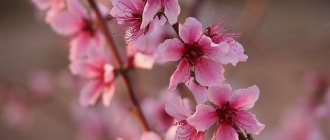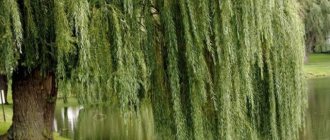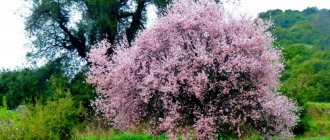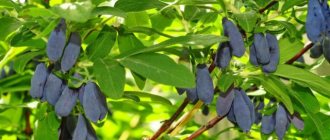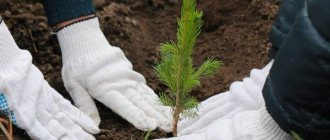Botanical description of the almond tree
The almond tree is often compared to Japanese sakura, it is so beautiful when in bloom. With the correct formation of the crown of the bush, the gardener can get a truly magnificent garden decoration. The subtle aroma of almonds and beautiful flowers will not leave either the site owners or guests indifferent. According to the botanical description, the almond tree belongs to the plum genus and the rose family, or Rosaceae. This plant is often called a nut, but it is a stone fruit shrub.
This shrub grows in Central Asia, the Mediterranean, as well as in the USA, China, Moldova, Mongolia, the Czech Republic, Ukraine and Russia. Most often, the crop grows in small groups of 5-6 trees of small height, usually in the mountains or in garden plots with proper care and pruning.
Not everyone knows how to cut almonds correctly; this skill needs to be learned. The quality of growth, the longevity of the crop, the shape of the crown and even fruiting depend on the correct pruning and formation of the plant. It is characteristic that the three-lobed species bears fruit with “fluffy” seeds, which are not edible, but look great on the branches and decorate the garden.
Russia and Ukraine are characterized by the cultivation of two decorative varieties of almond trees: the tender plum (Prunus tenella) and the steppe almond (also called “bean tree”). The first produces edible fruits, while the second produces fluffy fruits that are unsuitable for food.
Description of the plant
Almond is a subgenus of plants belonging to the genus Plum of the Rosaceae family. Although many are accustomed to the idea that it bears nuts, it is actually a stone fruit with an edible core. Therefore, it is not surprising that among the relatives of this tree, belonging to the same genus of plants, there are many other species with similar drupes:
- cherry;
- bird cherry;
- peach;
- apricot;
- cherries.
The almond tree is most common in warm countries, but you can also find it in the CIS - mainly in the south: in the Crimea, Transcaucasia, Central Asia, on the banks of the Danube. However, there are also varieties specially bred for cultivation in areas with more severe climates.
The Almond subgenus includes about forty plant species, and the most popular of them is the common almond. This is what is most often grown in gardens. It has two main varieties:
Bitter almonds (wild) - as the name suggests, its seeds cannot be eaten unprocessed, since poisonous hydrocyanic acid imparts bitterness to them. But you can get rid of it by heat treatment, and then the fruit can be used in cooking. In addition, almond oil is extracted from it.- Sweet almonds are almonds that are so familiar to everyone and have a pleasant taste. It is grown much more often. This is a cultivated variety of a wild plant, the fruits of which can be eaten without additional processing.
The history of this tree goes back many centuries: its first appearance is associated with the territories of the Mediterranean and Central Asia, and people began to eat it long before our era. Mentions of it can be found in the Bible. Now it is grown in many countries: in the USA, Mediterranean countries, Afghanistan, Iran, Australia. And in Tajikistan there is even an entire city dedicated to almonds.
How to care for an almond tree
Basic care for the shoots of an already planted almond bush consists of standard watering on a schedule, loosening the soil, weeding and removing weeds, fertilizing and pruning branches. It is imperative to treat the bush from parasites, rot and pests. Experienced gardeners recommend choosing standard complex fertilizers for such crops. They contain all the necessary nutrients and allow the plant to develop, bloom and bear fruit in accordance with seasonal cycles.
Is it possible not to carry out the procedure: consequences
Lack of pruning negatively affects the development of the almond tree. The most important negative impacts include the following:
- crown overgrowth;
- decreased fruiting;
- development of diseases;
- poor resistance to pests;
- faster aging of the plant.
Without pruning, improperly growing branches thicken the crown, and many diseased, broken, and deformed branches appear. As a result, the tree weakens and immunity decreases.
All about the almond tree - how to plant, feed, form and propagate
The closest relative of the plum, almonds, are valuable not for the pulp of the fruit, but for the kernel hidden inside the seed - a treasury of nutrients and microelements. During flowering, the almond tree becomes a real decoration of the site, filling the air with an intoxicating aroma.
Description of almond tree
Mistakenly classified by ordinary people as nuts, almonds belong to the stone fruit plants of the plum genus. Depending on the variety (and there are more than 40 of them), it can look like either a tree or a shrub. It has a powerful root system, capable of drawing water from a depth of up to 4-5 m. It is undemanding to soil, but thrives best on light and fertile soils. In swampy and acidified areas it grows poorly.
The crown shape can be pyramidal or spreading. The plant has the ability to branch heavily, so it needs regular shaping pruning. It begins to bear fruit 4-5 years after planting. In addition to being a source of delicious fruits, the almond tree is an ornamental plant that can decorate any garden. Single large white or pink flowers have a strong aroma that attracts bees, so almonds are also valued as an early honey plant.
Where does the almond tree grow?
The heat-loving almond tree actively grows and bears fruit in regions with mild winters: in the Crimea, the Caucasus, the Mediterranean, Central Asia, and the USA. Although almonds easily tolerate winter temperatures dropping to -30°C, spring frosts have a bad effect on their ability to bear fruit. For this reason, in the middle zone it is grown as an ornamental plant.
What does an almond tree look like?
The common almond has received maximum distribution. This is a plant with smooth bark and gray shoots. The height of an almond tree can reach 10 m, but on average it stops at 5-6 m. The leaves have a pointed lanceolate shape and a uniform dark green color. They are attached to short brown petioles. There are two types of shoots: generative (short) and vegetative (long). The almond tree tends to branch heavily; the lifespan of each shoot is 5-6 years. The flowers are large (up to 4 cm), solitary, strong aroma.
How does an almond tree bloom?
In regions with mild climates, almond blossoms can be observed from January to March. In the southern regions of Russia, its buds begin to bloom in April. A blooming almond tree is covered with a foam of white or pink petals, emitting a sweet, slightly bitter aroma. The shape of the flowers is goblet-shaped, diameter is from 2.5 to 4 cm. Depending on the variety, the flowers can be either simple or double.
Related article: Onion: growing and care, photo, how to grow from seeds in open ground
Almond tree - yield
The almond tree bears its first harvest 4-5 years after planting. The ability to bear fruit lasts up to 50 years, reaching a maximum at 15-20 years of age. The quantity and quality of fruits are influenced by many factors: the variety and age of the plant, the region of growth, and the amount of sunlight. The average almond yield from one tree is 8-10 kg of peeled kernels.
Propagation of almonds - by offspring or seeds
Almond bush is an ornamental flowering plant.
The easiest way to propagate the crop is by root suckers. But you can also use seeds. The seeds are planted in the garden before winter. For spring planting, they are stratified - placed in damp sawdust and kept in the refrigerator for 3-4 months. Seedlings that have grown to 30 cm are planted in permanent places. They begin to bloom after 2-8 years.
Green cuttings 15-20 cm long are also used for propagation. They must be kept in a root-forming solution for 15-16 hours, and then placed in a substrate of sand and peat (1:1), covered with a plastic bag. They take root within 1-3 months, after which the plants are planted in open ground. Almonds are also grafted onto bird cherry, cherry plum, plum and sloe rootstocks.
Almond tree - varieties
The best types of almonds were created on the basis of wild species and combine high nutritional characteristics with the ability to easily tolerate the vagaries of nature:
- Dessert - height up to 5 m. Blooms in May, buds are large, bright pink. The fruits are large, have a pleasant taste, and ripen in September.
- Foros - height up to 4 m, spreading crown. It blooms in May, the buds are medium-sized, pale pink. The fruits are large and soft-shelled. Zoned for the North Caucasus region.
- Slovenia - height up to 6 m, spherical crown. The first harvest is 6 years after planting. The fruits are large, easy to peel, and ripen in September.
- Nikitsky 62 – height up to 5 m, zoned for the southern regions. Afraid of frost, self-sterile. The fruits are sweet and contain a lot of oils.
Among the decorative varieties, one can highlight the three-lobed almond “Rosenmund”. This spreading plant, up to 3 m tall, is covered in bright pink terry buds in spring. Flowering occurs at the end of April even before the leaves appear. The flowers are medium in size, tightly pressed to each other. They exude a pleasant delicate aroma with a slight almond bitterness. The fruits are inedible and set extremely rarely.
What can be planted nearby?
The culture in question develops well in the vicinity of coniferous plants. It is better to choose dwarf shrubs: they will look good in decorative flower beds in combination with blooming almonds and will not pose a threat of shading. The distance between coniferous plantations and almonds should vary from 3 to 6 m.
Considering that almonds are a close relative of plums, such a neighborhood would also be good. But it is better, again, to choose a dwarf or columnar plum. You can plant cherry plum or thorn next to almonds. The main thing is that cultures do not obscure each other.
Almond tree - growing conditions
Growing a tree with almond nuts on your own plot is not difficult at all:
- We choose a seedling . It is better not to take risks and plant varieties and hybrids that are zoned for cultivation in a given area. An indigenous inhabitant of hot eastern countries, almonds easily tolerate winter frosts down to -35°C, but at the same time suffer from spring frosts, which have a detrimental effect on the future ovary. In areas with harsh winters and prolonged spring weather, almond trees are grown as ornamental plants.
- We determine the area . Almond trees have adapted to survive in arid regions with very hot climates. This made them not demanding on the quality of the soil: both rich black soil areas and poor rocky or sandy ones are suitable. The only thing they cannot tolerate is stagnation of groundwater and acidic soil reaction. The best option for planting an almond tree seedling would be a well-lit area protected from strong winds with light soil rich in nutrients.
- We select a company for the seedling . In order for an almond tree to bear fruit, it must be pollinated. Depending on the variety, two options are possible: cross-pollination (you will have to plant several more related seedlings at a short distance from each other) or insect pollination (several hives with bees should be placed nearby).
Errors
Improper pruning of a tree can prevent it from growing and developing properly. – Basic pruning errors:
- Untimely pruning . At the same time, plants can suffer for a long time and even reduce productivity. Spring work begins when the temperature becomes positive, and autumn work begins after the first strong drop in temperature.
- Irregular pruning . Some believe that if the tree is left undisturbed, nature itself will “take its course” and the almonds will bear fruit. Of course, this is true, but if you prune regularly, the result will be much more productive.
If trees are not pruned for several years and then all the procedures are carried out, it will be stressful for them, after which the plants will get sick for a long time. Therefore, tree pruning should be done regularly.
Branch cuts need to be treated with garden varnish. But there is a very important point here that not all gardeners observe: varnish cannot be applied to a wet surface. The sections should be given time to dry and only then a protective agent should be applied.
If you want to have a beautiful almond tree on your property, you need to take care of it. Regular pruning in spring and autumn will yield results; the almonds will not only have a well-groomed appearance, but also bear fruit regularly.
If you find an error, please select a piece of text and press Ctrl+Enter.
Almond tree - planting
Once the variety has been determined and the optimal location for growing almonds has been selected, planting work can begin. It is better to plan them for the fall, since spring planting often leads to the death of the seedling or a significant slowdown in its development. Let's look at how to plant an almond tree step by step:
- We dig a planting hole of approximately 60x60 cm for each seedling. Maintain a distance between seedlings of at least 4 m.
- At the bottom of the pit we lay a thick layer of drainage (brick fragments, crushed stone, gravel), which is necessary to drain water.
- Fill the hole halfway with soil-sand-turf mixture (ratio 1:2:3) with the addition of humus (5.5 kg) and superphosphate (0.5 kg). If necessary, reduce the acidity by adding dolomite flour or lime.
- We install a support in the hole, with which we then tie up an almond tree seedling.
- We cover the roots of the seedling with a clay mash, and then carefully straighten it inside the hole. In this case, the root collar should remain above the soil level.
- Carefully fill the hole with earth.
- We mulch the soil around the almond tree with peat, first watering it abundantly (at least 12 liters).
Subtleties of care and ripening time
When growing an almond plant, you need to take care of timely care, which includes:
- pruning;
- watering;
- loosening the soil;
- fertilizer;
- pest control.
Crown formation
Carry out timely and correct pruning of the almond tree throughout the year:
- After the end of winter, in early spring, before sap flow begins and the buds have not yet blossomed, they perform sanitary pruning of almond trees and bushes, shortening frozen growth, and removing dry or deformed branches.
- After flowering is completed, formative pruning is done - the seedling usually has three branches located one from the other at a distance of 0.2 m - they need to be shortened to 0.2 m. By shortening the faded growths by 70% of their length, you stimulate flowering for the coming year.
- Several times during the summer, excess growth is pinched out, and the necessary ones are shortened in July, when their length is half a meter.
- In the fall, after all the leaves have fallen off, another sanitary pruning is carried out.
On fruit-bearing trees, fatty growths are only cut out into rings, and damaged ones are shortened to 4 eyes.
Only branches that thicken the crown should be removed. The almond crown is formed by three levels of skeletal branches. After rooting, the seedling should be pruned so that its height is 1.2 m. The height of the trunk of a young seedling should be 0.5–0.7 m. Over the next 2–3 years, new levels of skeletal branches should form on the main conductor. To complete the formation of the crown, the main conductor is cut so that the last skeletal branch is half a meter below the conductor.
Video: how to form a tree from an almond bush
In the spring, before the start of sap flow, the old branches of seven-year-old bushes are cut off; they will be replaced by root shoots that appear after three years of life of the ornamental bush.
Important! If you cut down a powerful branch, do not forget to treat the cut with garden varnish. If you did not carry out sanitary pruning before the onset of frost, then it is better to postpone it to early spring.
Watering
The crop tolerates drought, but it will grow and bear fruit better with proper irrigation. When the bush blooms, it is necessary to water it abundantly. When the soil near the trunk dries out to a depth of 1.5 cm, the plant should be watered with 10 liters of water. Water at least once a week and a half, and more often in extreme heat. Avoid overwatering to prevent the root collar from rotting.
After moistening the soil, it lends itself well to loosening, so loosen 5 cm deep around seedlings and 10 cm around adult specimens.
It is important to remove weeds near the trunk. It is recommended to loosen the soil monthly
This improves access of oxygen and water to the root system and makes it possible to better absorb fertilizing. Gardeners mulch the soil around the trunk to retain moisture.
Selection of fertilizer and feeding
Throughout the year, gardeners apply fertilizers. Necessary:
- in the spring, mulch the circle near the trunk with manure or chicken droppings;
- before flowering, water the soil with a solution prepared from ammonium nitrate - 20 g, urea - 10 g, and water - 10 l;
- In the fall, fertilize the circle near the trunk with double superphosphate and potassium sulfate at the rate of 20 g of each product per 1 m² of soil.
During the first seven years, green manure is sown between the seedlings.
How to prepare a plant for winter?
Prepare heat-loving crops for winter, starting in summer. In September, when the harvest is harvested, the tops of the stems are pinched off. Before the onset of frost, the tree intensively grows wood fibers in order to better withstand the cold.
The seedlings are covered with dry leaves or lutrasil to a height of 15 cm. In this case, the root collar is left open. It is not necessary to insulate mature trees for the winter. If the branches freeze, the bush will recover very quickly in the spring. Young shoots of the crowns of standard plants are collected in a bunch and wrapped in felt to protect the flower buds.
Did you know? Almonds contain 67% fat, 30% protein, calcium, magnesium, phosphorus, vitamin E and B vitamins. The amount of protein in almond kernels is equal to its content in lean meat, and they are completely absorbed by the human body.
Almond tree care
The first years after planting, caring for an almond tree consists of regularly removing weeds from the tree trunk, loosening the soil in it and abundant watering. When irrigating, it is important to maintain the “golden mean”, giving the plant the required amount of liquid and avoiding stagnation with subsequent rotting of the trunk and roots. During this period, the seedling devotes all its efforts to strengthening the underground (root) part, so it hardly changes in appearance.
When the rooting process is completed, the phase of active growth of the above-ground part begins. The almond tree is rapidly increasing in growth and volume, producing more and more new shoots. Mandatory care includes regular application of fertilizers (a lot of them are needed, because a fast-growing tree spends a lot of energy and depletes the soil) and shaping pruning (without it, the crown thickens very quickly). If circumstances are favorable, already 5 years after planting you can enjoy the first harvest of delicious and very healthy almond nuts.
How to feed an almond tree in spring?
In spring, almonds need nitrogen more than ever. This microelement is necessary for the growth of shoots and the formation of buds. Fertilizing an almond tree with nitrogen is done in late April-early May by dissolving 25 g of ammonium nitrate in water and applying it to the tree trunk. Ammonia fertilizing can be combined with copper-containing fertilizer. To enrich the soil, saturating it not only with nitrogen, but also with oxygen, and also to attract pollinating insects to the almond trees, it is recommended to plant green manure (alfalfa, peas, mustard, lupine and other crops) between them.
Related article: Coriander: planting and care in open ground, growing from seeds, beneficial properties
How to form an almond tree?
For the crop to fully ripen, sunlight is necessary, so it is important to understand how to properly prune an almond tree:
- Almonds are pruned twice a year, at the beginning and end of the growing season. This allows you to save the strength of the tree and avoid thickening the crown.
- After planting, the seedlings are pruned at a height of 1.2 m, forming a standard of 80 cm and a crown of 40 cm. On the standard, all shoots are cut into a ring, and in the crown area they are shortened by 2-3 eyes. The strongest 3-4 shoots are left; they will later become skeletal branches. This is how a bowl-shaped crown is formed over several years.
- Pruning mature trees involves removing crooked, damaged and broken shoots.
- Old and unpruned almond trees can be rejuvenated by radical pruning.
How to propagate an almond tree?
In nature, almond propagation occurs by seeds; in culture, vegetative methods are more often used: root shoots and cuttings. Standard decorative almonds can be propagated by budding using a plum as a rootstock. Let's take a closer look at how to grow an almond tree from a cutting:
- Propagation material is prepared in July by cutting strong cuttings at least 15 cm long, with two nodes, lignified, but not yet lost their flexibility.
- The cuttings are rooted in the schoolhouse, where they will overwinter. The soil there should be nutritious and loose (a mixture of fertile soil and peat). For the winter, the schoolchild must be protected from frost with lutrasil, straw or fallen leaves.
Choosing a landing site
It must be remembered that almonds are a heat-loving plant that needs sunlight. Therefore, when choosing a place, you need to take everything into account: it should warm up well and not be blown by winds. Pay attention to the photo of the almond tree below. Do you want such beauties to grow in your garden? Then provide the seedlings with optimal conditions and proper care, and the trees will repay you handsomely.
There should be no buildings or tall trees near the planting site that would create shade. Otherwise, the plant will simply die.
Now that it is known how to germinate seeds and select seedlings, we should tell you how to maintain an almond tree. Planting and caring for this plant are procedures that, of course, require a little gardening skills, however, if you follow the tips below, even a beginner can grow almonds without any difficulties.
Description and flowering of an ornamental shrub
The almond tree reaches a height of 4-6 meters, and the bush 2-3 meters. The rhizome consists of 3-5 skeletal roots, which are able to penetrate deep into the soil, thereby protecting itself from drying out.
The plant is quite branched, and it consists of two types of shoots, which include shortened generative and elongated vegetative ones.
The dark green leaves are attached to brown petioles and have a lanceolate shape with a pointed tip.
The flowers of this plant consist of 5 petals painted white or light pink. On average, the diameter of one flower is 2.5 centimeters.
The almond fruit is a dry and velvety drupe with a leathery and fleshy green pericarp.
After drying, the pulp is very easily separated from the edible seed, which is oval-shaped and long, equal to 2.5 - 4 centimeters. It is characterized by the presence of a large number of grooves.
The first fruiting occurs in the 4-5th year of the tree's life , but it appears in full force only in the 10th-12th year. With good care, the shrub bears fruit for 30-50 years.
In addition to producing fruit, almonds are also grown for decorative purposes . The pink or white foam of the flowers of such a tree not only decorates the garden in early spring, but also exudes a unique aroma.
Almonds bloom in March-April with white or light pink flowers.
Almond is a plant whose pollination needs to be taken care of in advance. There are two types of trees:
- the former need cross-pollination , so at least 3 pollinators are planted next to the fruit-bearing almonds, the flowering times of which must coincide;
- the latter are pollinated with the help of bees , so it is advisable to have 2-3 hives next to the plant.
Initially, it was believed that almonds could only be grown in the southern regions, but with the development of scientific technologies, breeders have developed varieties that, with proper shelter, can survive even the harshest winter.
Collection and storage of fruits
After the tree flowers, fruits begin to form in July-August. They begin to be collected when the outer shell of the fruit darkens and cracks. Next, they are cleaned - the peel is removed. Then, spread out in one layer, dry for several days. Store the finished fruits in fabric bags.
Did you know? The high value of nut oil is that it helps cure pneumonia, asthma, stomatitis, heart disease, eliminates skin irritations, strengthens hair, stimulates its growth, and gives it shine. The oil is used as a base for creams, as it, when absorbed, helps restore skin cells.
Carefully monitor the moisture content of the fruit and kernel, which should not exceed 10%. If the humidity is higher, it is necessary to quickly clean the fruits and dry them to avoid troubles in the form of mold and rotting. Half-raw fruits must not be stored in piles or piles for more than one day.
Different varieties of almonds are collected in separate containers to prevent them from mixing, because this would be an extra labor cost for cleaning and sorting
Young almond trees 1.5–2 m high allow you to cut the pericarp manually, without a stepladder. To collect fruits on taller trees, for example, from 2 to 3.5 m in height, they are shaken, having previously spread a cloth or film under the trees.
Important! The quality of finished almond kernels must comply with established state standards. Purchase prices are set for sweet almonds with a moisture content of 10%
Almonds are used for landscaping and decorating parks, city boulevards, and suburban areas. Nuts are used as medicine and an additional source of vegetable fats and proteins. Proper and timely care will allow you to obtain the valuable fruits of this tree, as well as decorate your garden with ornamental bushes.
Varieties
Sweet varieties of almonds are grown in cultivation; the following types are especially popular:
- Jubilee - the variety blooms quite late and has good drought resistance. The skin is medium thick and the kernel is sweet, firm and dry;
- Ayudagsky - this variety is late-ripening and early-fruiting, the first fruiting occurs already in the 3rd year of the tree’s life. The fruits, covered with a soft shell, have a dense, slightly flattened oval kernel of light brown color;
- Sevastopol - such almonds boast excellent resistance to heat and drought, and they also produce a huge amount of harvest. The shell of the fruit is soft, and the kernels themselves are dense, sweet, and colored white;
- Mangul - this late-ripening variety is not afraid of drought. Hard and dense kernels with increased oiliness are covered with a soft shell. A distinctive feature will be good immunity to most diseases and pests;
- Dessert - such self-sterile almonds are well suited for growing in central Russia, because they are not afraid of return frosts and frostbite of flower buds. The shell is soft and rough. The oval-shaped kernels are very sweet and buttery. Primorsky or Spicy almonds are usually used as pollinators for this variety.
Rules for planting an almond tree in open ground
It is best to grow almonds from annual seedlings , which are placed in open ground at the beginning of March or at the end of November.
As a place for planting, choose a sunny area, protected from drafts and gusty winds; almonds can also grow well in partial shade.
Before planting the plant, you need to prepare a hole. In the fall, two weeks before planting, pits are dug, the diameter and depth of which will be 50-70 centimeters.
Related article: Sweet potato (sweet potato): planting and care in open ground, photo, growing from seeds
If almonds are planted in groups , then the distance between individual trees should be 3-4 meters, and between rows 5-6 meters.
It is best to grow almonds from annual seedlings, planted in March or November
consisting of crushed stone or gravel is laid at the bottom of each pit Then fertile soil is placed in them, consisting of the following elements:
- 1 part sand;
- 2 parts humus;
- 3 parts leaf soil;
- 5-6 kilograms of rotted manure or humus;
- 500 grams of superphosphate;
- in the presence of acidic soil, additionally add 200-300 grams of dolomite flour or lime.
After the hole has settled sufficiently, you can begin planting the tree :
- Initially, a support 1-1.5 meters high is dug in the center of the pit;
- then a hill of earth is built around it;
- the seedling is placed on a mound so that the root collar is 3-5 centimeters above the ground;
- at the next stage, the hole is filled with fertile soil, compacted and thoroughly watered;
- as soon as the water is completely absorbed, the seedling is tied to a support and the soil is mulched with a 3-5 centimeter layer of peat or dry leaves.
When planting in spring, the hole is also prepared in the autumn.
How to plant almonds correctly:
Design and landscape with almonds
Decorative almonds are very beautiful and will be an excellent addition to decorating a garden with rocky elements, imitating their natural location. Today in standard culture and lawns you can find both a beautiful single planting and a spectacular arrangement of several pieces (up to 5).
Landscape designers do not miss the opportunity to use almonds - the ornamental shrub has unusually beautiful flowering. But if you are new to this area, then expert recommendations will help you use the plant correctly:
- It is better to do single plantings, maintaining a distance between the bushes;
- When planting in groups, it is better to use different varieties that have different heights. The combination with crops that have red leaves is popular;
- The decorative bush at the entrances looks beautiful;
- the best background for almonds is a green, well-groomed lawn;
- decorative bush is often used when decorating a garden in an oriental style. This is the most beneficial combination;
- designers use bushes to decorate hedges, and constant pruning will help give the crown an unusual, attractive shape, making a beautiful fence;
- Using decorative almonds you can solve the problem of soil shedding. The plant's root system is so large and strong that it can hold the soil.
Almond is an ornamental shrub that will transform even the most inconspicuous area and give it interesting notes. Proper care, propagation and planting of the plant will help to beautifully decorate the garden. There is nothing complicated about this, the main thing is to follow the recommendations.
- Ranunculus - planting and care in open ground
- Muraya: the first emergency aid that is always there
- Varieties of edible physalis with photo
- Pests of indoor plants and flowers, methods of combating them
- Pitahaya or dragon fruit: growing at home
- Stromantha diseases with photos
- How to prepare lavender for winter
- How to plant grapes in the fall using cuttings
Almond care
Almond care consists of several standard procedures that must be followed when growing almost all fruit trees.
For best fruiting, almonds need regular watering . Young plants are watered every 2 weeks, and adults once every 20-25 days.
Loosening the tree trunk has a beneficial effect on tree growth. The first time such work is carried out at the end of March to a depth of 10-12 centimeters.
Then, during the entire growing season, another 3-4 loosenings are carried out, but to a depth of 6-8 centimeters. It is also necessary to remove weeds in a timely manner.
In the fall, the following mixture is added to the tree trunk circle for digging::
- 1 kilogram of manure;
- 20 grams of potassium sulphide;
- 40 grams of superphosphate.
During the first 5-7 years of tree life, it is recommended to grow green manure in the inter-row spaces.
In Siberia, you can grow bean, steppe, low or Russian almonds without shelter. Three-lobed almonds grow well in the central zone.
Caring for almonds involves regular watering, loosening the tree trunk, and fertilizing
We insulate almonds for the winter
Low steppe almond
Water the crop moderately. Fertilize the plants in the spring with a solution: 20 g of saltpeter, 10 g of urea and 1 kg of mullein per 10-liter bucket of water. And in the fall, plant 20 g of potassium sulfate and superphosphate into the soil under them.
Before flowering, sanitary pruning is carried out with the removal of branches older than 7 years. After flowering, formative pruning is done, shortening annual shoots by 1/3. (In our climate, I try to form crowns in the form of bushes.) At the end of summer, the apical buds are cut off to stimulate lignification of the shoots and prevent them from freezing in the winter cold.
I insulate almonds for winter by tying the bushes and wrapping them in 2 layers of non-woven material. Since it blooms early, I use smoke, spraying or covering material to protect the flowers from frost.
The abundant, early flowering of almonds grown in the south can be forever remembered for its splendor. Pink flowers and a sweet aroma are reminiscent of distant lands and endless summer. But the almond tree is not exotic at all. In temperate latitudes, its cultivation is quite possible. Released varieties are not only decorative, but also produce good yields of healthy fruits.
If in winter the air temperature does not drop below 25 ° C, then the shrub can easily grow in the open ground of an ordinary garden. If several rules are followed, almonds produce from 6 to 10 kg of fruit per season and live up to 100 years.
Trimming
At the beginning of spring, before the buds open, it is necessary to remove all frozen, broken, diseased or deformed branches.
After flowering has finished, you can begin formative pruning , during which 3 tiers of skeletal branches are produced:
- in the first year, select three branches located 15-20 centimeters from each other and shorten them to a length equal to 15 centimeters;
- the next 2-3 years, 3 tiers are formed on the central conductor, located at a distance of 20-30 centimeters;
- Shoots that are insignificant for crown formation are pinched several times during the summer;
- the rest are cut to 50-60 centimeters;
- upon completion of the work, the central conductor is shortened so that the distance between it and the upper tier is 55-60 centimeters.
In autumn, after the leaves fall , sanitary and anti-aging pruning is carried out. That is, all dry, diseased, broken branches, growing in the wrong direction and thickening the crown are removed.
It is worth remembering that when pruning thick branches, the cut site must be treated with garden varnish.
Almonds are pruned in the spring, after flowering has ended, and in the fall, after the leaves have fallen.
Propagation of almonds - by offspring or seeds
The easiest way to propagate the crop is by root suckers. But you can also use seeds. The seeds are planted in the garden before winter. For spring planting, they are stratified - placed in damp sawdust and kept in the refrigerator for 3-4 months. Seedlings that have grown to 30 cm are planted in permanent places. They begin to bloom after 2-8 years.
Green cuttings 15-20 cm long are also used for propagation. They must be kept in a root-forming solution for 15-16 hours, and then placed in a substrate of sand and peat (1:1), covered with a plastic bag. They take root within 1-3 months, after which the plants are planted in open ground. Almonds are also grafted onto bird cherry, cherry plum, plum and sloe rootstocks.
Diseases and pests
The most common types of diseases found on almonds are:
- Cercospora blight - initially brown spots with a diameter of 2-4 millimeters appear on the leaves, on which a gray coating can be seen. Then the center of the leaf dries out and falls off.
- Scab is a fungal disease that affects the leaves, flowers and shoots of trees.
- Rust - red spots appear on the upper side of the leaf, and brown pads on the inside. Over time, the leaves dry out and fall off.
- Hole spot - the disease affects all parts of the tree. It can be detected on the leaves, because characteristic spots of red shades with a dark border along the edges appear on them.
- Gray rot - brown spots and a gray fluffy coating appear on the shoots.
Among the pests on almonds, you can find insects such as seed beetles, aphids, leaf rollers or spider mites .
Aphids on almond tree leaves
To control pests, trees must be treated with insecticides, which include Actellik, Fufanon, Tagore.
Biotlin or Antitlin are used against aphids. You can get rid of spider mites using Apollo, Agravertin or Fitoverm.
As you know, it is much better to prevent the occurrence of any trouble than to treat it, so preventive measures will be extremely effective:
- in early spring, before buds form, the tree and the soil around it are treated with a 1 percent solution of Brodka liquid;
- after the end of leaf fall, the treatment should be repeated;
- The best preventive measure would be to adhere to agricultural cultivation techniques. This includes proper watering, weed removal and sanitary pruning.
The almonds are removed only after the green outer shell has darkened and can be easily separated from the kernel.
Features of cold-resistant almond species
Steppe almonds are considered the most winter-hardy. This is a low-growing shrub, its height does not exceed 1.5 meters. The branches are erect, the bark is gray-red. The steppe species is interesting because its pericarp is pubescent, as if covered with felt. The fruits decorate the branches all autumn.
The steppe species has a lot of root shoots, which are used for its propagation. Only sanitary pruning is required, which is carried out in early spring. This species is undemanding to soil, tolerates polluted air, and can easily withstand drought - it requires minimal care. It is used for landscaping streets and courtyards in the city.
One of the common three-lobed varieties is “Pink Foam.” It has beautiful large double flowers of pink, crimson or purple color. The root system of this variety is superficial and highly branched. The “Pink Foam” variety is suitable for strengthening slopes and artificial embankments.
Using a flowering tree in landscape design
Almonds have very beautiful and unusual blooms , for which they are often planted for decorative purposes. Early flowers can only decorate a waking garden and create a spring mood.
The almond tree is an amazing flowering plant , which in modern conditions can be grown in any corner of the country. If you follow all the recommendations correctly, you can get very tasty bone fruits.
Sources:
https://fermer.blog/bok/sad/orehi/mindal/mindal-vyraschivanie-i-uhod/12754-strizhka-mindalnogo-dereva.html https://www.xn--80afdb0cbapl.xn--p1ai/vse -o-mindalnom-dereve-kak-posadit-podkarmlivat-formirovat-i-razmnozhat/ https://profermu.com/sad/derevia/mindal-derevo.html




